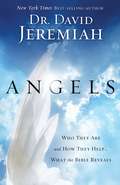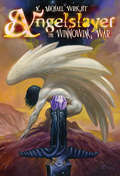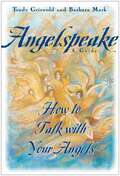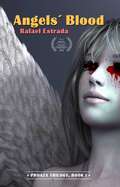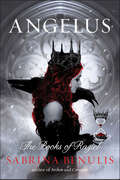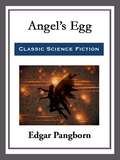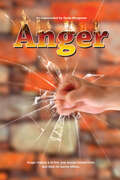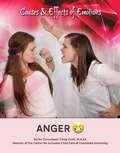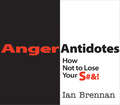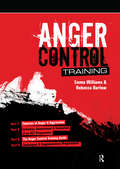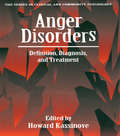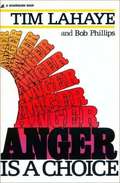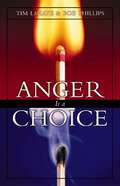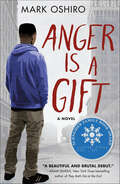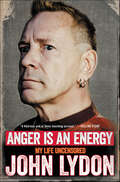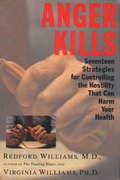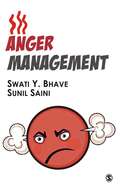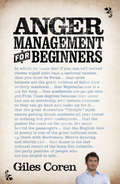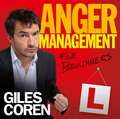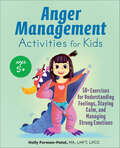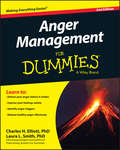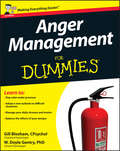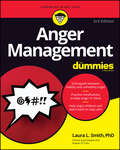- Table View
- List View
Angels: Who They Are and How They Help--What the Bible Reveals
by Dr David JeremiahSeparate Fact from Fiction For centuries, men, women, and children have been fascinated by stories of angel sightings. Yet many contemporary beliefs are based on misconception and myth rather than solid, biblical truth. Responding to our widespread, modern cultural interest in the agents of heaven and their role in our world, popular Bible teacher Dr. David Jeremiah provides an in-depth, biblical look at the hot topic of angels. His broad and thorough survey of scriptural teaching is illustrated by powerful quotes from prominent teachers Billy Graham, Corrie ten Boom, C.S. Lewis, and others. Separate Fact from Fiction Popular Bible teacher Dr. David Jeremiah explores the Bible's rich teaching on angels, revealing a fascinating doorway into reliable, eye-opening truth. Discover the reality of how angels can draw you closer than ever to God as you sharpen your sensitivity toward spiritual realities. [Endorsements] "Outstanding! As one would expect from David Jeremiah, this book reflects a theologian's concern, a pastor's heart, and a Biblicist's accuracy." --Dr. Bruce Wilkinson, New York Times bestselling author "David has that uncanny ability to be deliberate without being dull. His words will deepen your gratitude for God's messengers in light of God's Word." --Max Lucado, pastor and bestselling author "Dr. David Jeremiah shifts the focus from contemporary 'angel hype' to the fascinating biblical truth about God's powerful messengers." --Dr. John C. Maxwell, founder of INJOY, Inc. Story Behind the BookEndorsements "Simply put, this is an outstanding book! As one would expect from David Jeremiah, this book reflects a theologian's concern, a pastor's heart, and a biblicist's accuracy." --Dr. Bruce Wilkinson , New York Times bestselling author "David has that uncanny ability to be deliberate without being dull. His words will deepen your gratitude for God's messengers in light of God's Word." --Max Lucado, pastor and bestselling author "Dr. David Jeremiah shifts the focus from contemporary 'angel hype' to the fascinating biblical truth about God's powerful messengers." --Dr. John C. Maxwell, founder of INJOY, Inc.
Angelslayer: The Winnowing War
by K. Michael WrightSet amidst an eerie and distant future, this novel tells the story of Etlantis#151;the mother city built in the shadows of Mt. Arom#151;and the possible end of the world. Believing in their right to rule the planet, the people of Etlantis sent ships to hunt the Western Seas. In them were the Nephilim#151;sons of Angels who had become addicted to human flesh and blood through the curse of Enoch. In the wake of their terror, the earth's human population has neared extinction. Unless the survivors can band together to destroy the monsters that ravaged their home, the end is all but certain Featuring an imaginative range of characters and concepts, this is a harrowing vision of the line between heaven and earth.
Angelspeake: How to Talk With Your Angels
by Trudy Griswold Barbara MarkYour angels want to speak to you! It's important to them that you know who they are and that you receive their loving messages of guidance and support. It's easy to communicate with them. Now, in this simple, practical guide, Barbara Mark and Trudy Griswold show you that the act of writing to your angels and receiving answers means that you can take the initiative and ask for help, for understanding, for love. In Angelspeake you will learn how rewarding and helpful it is to meet your angels. Barbara and Trudy give you clear step-by-step instructions on how to bring angelic teachings into your life using the Four Fundamentals for initiating spiritual assistance: Ask for the angels to be with you. Believe and trust that they will be there. Let It Happen and begin writing. It's the same loving voice you have heard many times before. Finally, Say Thank You. It's that simple! Angelspeake is filled with inspirational angel teachings and true stories of people whose lives have been changed by association with the angels. Barbara and Trudy teach that you can receive helpful personal information by talking with your angels whether you are in a personal crisis, looking for a new job or relationship, or want to buy a house. The angels will help!
Angels´ Blood
by Rafael EstradaThe decapitated body of a thirteen-year-old girl turns up at a coastal location in Mar Menor. Not far from the place, the Police finds a sleeping young man wearing a bloody t-shirt and displaying clear signs of alcoholic intoxication. The solution of the case seems so evident, that the Captain of the precinct where the events occur, assigns it to a rooky inspector thinking that this would be a good way to get the new cop's feet wet in investigative procedure. Chief De la Mata expects the case to be closed promptly. That is how, from one day to the next, Juanito Proaza finds himself partnering veteran policeman Paco Garrido, who likes to use unorthodox methods, and working closely with Doctor Luzon, a brilliant pathologist and a great master at presenting his findings with great dramatic flair. Juanito heads an investigation that gets complicated by the minute and eventually results in the uncovering of a sordid net with multiple tentacles, among these a mysterious literary society dedicated to paying cult to…angels.
Angelus: The Books Of Raziel (The Books of Raziel)
by Sabrina BenulisThe heart-pounding conclusion to the Books of Raziel trilogy, a gothic supernatural tale about a girl who discovers she holds the keys to both Heaven and Hell—and that angels, demons, and all the creatures in between will stop at nothing to possess her and control that power.Like sand in an hourglass, time is slipping away . . .The war started by three powerful angel siblings—Raziel, Lucifel, and Israfel—has divided the kingdoms of both Heaven and Hell for ages. Now, that destruction is spilling over into the human world, and only the Archon can stop it.She is Angela Mathers, a human who sits on the Devil’s vacant throne, seemingly fulfilling a prophecy of ruin. As the Archon, Angela alone can oppose Lucifel and open Raziel’s Book to use its power for good. But to do so would mean murdering her best friend, Sophia, and that’s a sacrifice Angela refuses to contemplate.But ruin does not always mean destruction—sometimes it means revolution. Echoes of the past have resurrected the Angelus, the Song of Creation, and its notes are somehow linked to the Book. Now Angela must discover the truth behind the song and her own origins, but time is running out. There are dark forces who believe Angela’s success will not end tragedy but continue it, and they’re determined to stop the Archon’s destiny once and for all.
Angelwalk: On Holy Ground
by Roger ElwoodBASED UPON FACT The mysterious realm of spiritual warfare plays a vivid part when a madman enters a church, opens fire on hundreds of young people, killing seven and wounding others. Award-winning author Roger Elwood lifts the veil between the natural world and the supernatural. In this latest sequel to the original Angelwalk novel, he creates a new genre, blending reality with the literary techniques of his internationally best-selling series. True-life human drama has never been more compelling. Expect to be startled.. .shed tears.. .rejoice. Learn the truth, and that truth will set you free. An Angelwalk Novel Like No Other
Angel’s Egg
by Edgar PangbornWhen adopting a pet, choose the species that is most intelligent, obedient, loyal, fun to play with, yet a shrewd, fearless protector. For the best in pets--choose a human being!
Anger
by Dada BhagwanAnger management is a popular and necessary topic in today’s world. In dealing with difficult people, in our family relationships, or in facing marriage problems, we simply do not know how to deal with anger! When dealing with anger, we may wonder, “Am I right?” or “How can I make myself understood?” Some of our relationships can be said to be the very definition of conflict! Lacking conflict resolution skills, and out of a sense of powerlessness in our circumstances, we become angry. In the book “Anger”, Gnani Purush (embodiment of Self knowledge) Dada Bhagwan offers the ultimate anger management techniques in the form of spiritual conflict resolution strategies. He gives numerous solutions for dealing both with our own anger, and the anger of others. In addition, Dadashri offers spiritual advice on how to handle difficult people, anger management tips, and relationship tips.
Anger
by Rosa WatersAnger is an emotional response to something that threatens your well-being in some way. Too much anger can damage your body. It can hurt your relationships with others, and it can make you unhappy and miserable. But anger can also be a powerful source of energy that pushes you toward a happier life. It's a signal that something is wrong. It tells you to pay attention--and then take action. So next time you feel angry, stop and pay attention--then use an anger-management tool to channel your angry feelings in positive ways. Let your anger empower you to change the world. Discover how inside this book!
Anger Antidotes: How Not to Lose Your S#&!
by Ian BrennanStrategies for living a crisis-free life in an imperfect world. Anger is at the root of most of the personal dilemmas we face. Frank, personal, and pithy, this book engages readers in a no-nonsense exploration of how we can effectively reach beyond ourselves to maintain calm in the face of crisis. The objective is to distill down to fundamental aspects the universal structures that form the basis of most human problems. It is usually our emotions that interfere with making sound choices. Thus, even the most learned individuals, who "know better," are capable of making colossally stupid errors in judgment and conduct. Presenting a range of deescalation techniques, each chapter has been concentrated into "mini- manuals" that in their totality contain a library's worth of material. The left side of each two-page spread describes the anger trigger and the right side of the page spread contains the anger antidote. Topics covered include emotional immaturity, the absence of thought, extremes, inertia, reactor bait, and argument traps.
Anger Control Training
by Rebecca Kelly Emma WilliamsThis training manual addresses the need for a practical and easily accessible guide for professionals working with people presenting with anger problems. It is intended for use by psychologists, OTs, psychiatric nurses, probation officers, psychiatrists, social workers and teachers. This training manual offers a wealth of photocopiable material, including client handouts and facilitators guides. The appendices contain materials for role-play and relaxation. "Anger Control Training" is a comprehensive programme using a cognitive-behavioural approach and designed for the professional to help people change their thoughts, feelings and behaviour.
Anger Disorders: Definition, Diagnosis, And Treatment (Series In Clinical And Community Psychology Ser.)
by Howard KassinoveAnger is a daily experience. It is encountered in a number of interpersonal, family and occupational situations. Research indicates that even "normal" parents worry that they will lose control of their anger and harm their children. When short-lived and of low intensity, anger may be of some help to us; in contrast, when it is persistent and intense, it is typically highly disruptive.; This text reviews facts and theories of anger. Anger is differentiated from annoyance, fury, rage, hostility and the behaviours of aggression and violence, and attention is paid to understanding anger both as a normal experience and as a clinical disorder. Specific anger diagnoses are presented to describe disruptive anger states and traits. Anger in criminal populations is also discussed and behaviour-analytic, cognitive-constructivist and cross-cultural perspectives are presented in detail.; The book argues that it is important to understand the causes, correlations and outcomes of anger and to develop effective remediation programmes when anger is excessive and disruptive. Thus, following a meta-analyses of the effectiveness of published treatments, two chapters present "ideal" therapy programmes for adult and childhood adolescent anger disorders. Finally, a model is presented to help understand anger development and resolution.
Anger Is A Choice
by Tim Lahaye Bob PhillipsAnger is a powerful emotion that we can feel and use in many different ways. From marital screaming matches to road rage and the silent treatment shared by business colleagues, anger is expressed in ways that undermine our most important relationships. Many people wonder how they can handle their angry feelings in a way that helps them get what they need. In this book, the authors discuss the many faces of anger and help readers discover an effective and Biblical way to cope with the power of anger.
Anger Is a Choice
by Tim Lahaye Bob PhillipsWhat you need to know to control the emotion of anger and find healing for damaged relationships. Anger is something everyone struggles with--whether it’s our own emotion threatening to explode out of control or the anger of others that makes us feel intimidated and afraid. But when we understand where anger comes from, how it shows or doesn’t show, then we can do something about it. Either it will control us or we will control it, because Anger Is a Choice. Best-selling authors Tim LaHaye and Bob Phillips tell us what we need to know to control the emotion of anger. They not only examine it from beginning (its origins) to end (its effects), they also help us evaluate our own “Irritability Quotient” through the Anger Inventory and other exercises throughout the book. In learning how to handle conflicts and anger, we are enabled to heal damaged relationships and help others deal with their anger as well. We can make our lives more peaceful, rewarding, and meaningful by putting anger in its proper place and under our own control. Topics include: * Meet the angry family * Anger and body language * Anger and your health * Anger and your temperament * Is it ever right to be angry? * Anger and forgiveness * Anger in the Bible
Anger Is a Gift: A Novel
by Mark Oshiro*31st Annual Lammy Finalist forLGBTQ Children’s/Young Adult category**2019 ALA Schneider Family Book Award Teen Winner**Buzzfeed's 24 Best YA Books of 2018**Vulture's 38 Best LGBTQ YA Novels**Book Riot's Best Books 2018**Hyable's Most Anticipated Queer YA Books of 2018**The Mary Sue's 18 Books You Should Read in 2018*Moss Jeffries is many things—considerate student, devoted son, loyal friend and affectionate boyfriend, enthusiastic nerd. But sometimes Moss still wishes he could be someone else—someone without panic attacks, someone whose father was still alive, someone who hadn’t become a rallying point for a community because of one horrible night.And most of all, he wishes he didn’t feel so stuck.Moss can’t even escape at school—he and his friends are subject to the lack of funds and crumbling infrastructure at West Oakland High, as well as constant intimidation by the resource officer stationed in their halls. That was even before the new regulations—it seems sometimes that the students are treated more like criminals. Something will have to change—but who will listen to a group of teens?When tensions hit a fever pitch and tragedy strikes again, Moss must face a difficult choice: give in to fear and hate or realize that anger can actually be a gift.At the Publisher's request, this title is being sold without Digital Rights Management Software (DRM) applied.
Anger Is an Energy: My Life Uncensored
by John LydonFrom the legendary frontman of the Sex Pistols, comes the complete, unvarnished story of his life in his own words.John Lydon is an icon—one of the most recognizable and influential cultural figures of the last forty years. As Johnny Rotten, he was the lead singer of the Sex Pistols-the world’s most notorious band. The Pistols shot to fame in the mid-1970s with songs such as “Anarchy in the UK” and “God Save the Queen.” So incendiary was their impact at the time that in their native England, the Houses of Parliament questioned whether they violated the Traitors and Treasons Act, a crime that carries the death penalty to this day. The Pistols would inspire the formation of numerous other groundbreaking groups and Lydon would become the unlikely champion of a generation clamoring for change.Following on the heels of the Pistols, Lydon formed Public Image Ltd (PiL), expressing an equally urgent impulse in his character: the constant need to reinvent himself, to keep moving. From their beginnings in 1978 PiL set the groundbreaking template for a band that continues to challenge and thrive to this day, while also recording one of the eighties most powerful anthems, “Rise.” Lydon also found time for making innovative dance records with the likes of Afrika Bambaataa and Leftfield. By the nineties he’d broadened his reach into other media while always maintaining his trademark invective and wit, most memorably hosting Rotten TV on VH1.John Lydon remains a captivating and dynamic figure to this day—both as a musician, and, thanks to his outspoken, controversial, and from-the-hip opinions, as a cultural commentator. In Anger is an Energy, he looks back on a life full of incident, from his beginnings as a sickly child of immigrant Irish parents growing up in post-war London to his present status as a vibrant, alternative hero.The book includes 70 black-and-white and color photos, many which are rare or never-before-seen.
Anger Kills
by Redford WilliamsDr. Redford Williams reveals ground-breaking research that confirms that hostility not only is a serious barrier to happiness, but can lead to heart disease and other life-threatening illnesses. Dr. Williams and his wife, Virginia, team up to present the latest research in the field and offer seventeen practical strategies that can help readers translate scientific theory into meaningful action. Begin by taking the Hostility Questionnaire, which will help you assess the degree to which hostility, cynicism, and aggression rule your life. Then start a Hostility Log and follow the Hostility Roadmap to keep track of those incidents or people that really push your buttons. With these insights, you can then move on to sample any or all of the seventeen different strategies to reduce the wrath that sabotages your health and can drain your life of joy and pleasure. In writing Anger Kills, the authors draw not only on the latest research, but on their own experiences as a couple for more than twenty-nine years and on the experiences of couples who have used the Williamses' methods successfully in various workshops the authors have led. The result is a combination of solid science with empathic explorations of the nature of human relationships and caring. This is science with a heart.
Anger Management (Response Books)
by Swati Y Bhave Sunil SainiIn today′s world, problems of anger, rage, aggression and violent outbursts have reached a critical point where they threaten the ethos of the modern society, and hence, need to be effectively managed. Anger management is a term that we all can instantly relate to. Laying out a host of effective tips to manage anger, this book comes with the power to change things for the better. The key features of the book are: - Explanation of the confusing emotion of anger in simple terms, including the physiology of anger and its deleterious effects. - Detail anger management techniques for individuals, family, school and workplace. - Easy tips to master anger where chronic anger and unhappiness translates into negative human behavior: abusive love relationships, dating violence, date rape, drug abuse, driving aggression, robbery, gambling, suicidal ideation, sensation seeking and other impulse control behaviors. - A to Z tips for self-management of anger. - How to reconstruct their negative thoughts, feelings and behaviors with emphasis on therapeutic intervention for serious anger problems. This book provides useful tips on mastering the art of anger management. Its lucid narration and the use of cartoons and illustrations make it an interesting, entertaining and effective read for professionals as well as lay persons, Physicians, psychiatrists, psychologists, and counselors can also recommend this book to their patients.
Anger Management (for Beginners)
by Giles CorenFat people, Footballers, Flip-flops, Formula One, Wheelie luggage Cycle helmets, Processed ham, Skiing, Dogs,,, Are you all wound up? Boiling and ready to blow? Breathe deeply. Relax. Master of spleen Giles Coren, author of what The Guardian called 'The Maddest Email Ever', has an unbeatable technique for working through the anger: He does it for you.
Anger Management (for Beginners)
by Giles CorenFat people, Footballers, Flip-flops, Formula One, Wheelie luggage Cycle helmets, Processed ham, Skiing, Dogs,,, Are you all wound up? Boiling and ready to blow? Breathe deeply. Relax. Master of spleen Giles Coren, author of what The Guardian called 'The Maddest Email Ever', has an unbeatable technique for working through the anger: He does it for you.
Anger Management (for Beginners)
by Giles CorenFat people,Footballers,Flip-flops,Formula One,Wheelie luggageCycle helmets,Processed ham,Skiing,Dogs,,,Are you all wound up? Boiling and ready to blow? Breathe deeply. Relax.Master of spleen Giles Coren, author of what The Guardian called 'The Maddest Email Ever', has an unbeatable technique for working through the anger: He does it for you.(P)2010 Hodder & Stoughton
Anger Management Activities for Kids: 50+ Exercises for Understanding Feelings, Staying Calm, and Managing Strong Emotions
by Holly Forman-PatelStand up to your angry feelings—50+ fun, anger management activities for kids ages 5 to 7Everyone gets angry, and that's OK—it's how you express your angry feelings that really matters. Anger Management Activities for Kids is filled with more than 50 engaging exercises to help you understand and manage your anger so you can express yourself safely, without hurting others or yourself.Discover enjoyable activities that illustrate where anger comes from, what it feels like, how to show your feelings, how to tame your temper, and even how to understand and help other people when they're angry. With this workbook about anger management for kids, you'll use your imagination, have fun, and get creative as you learn how to show your anger who's boss!This book about anger management for kids includes:A mix of activities—In this fun book about anger management for kids, you can explore different ways to conquer your anger with awesome exercises like drawing, writing, thinking, and moving your body.Other kids' stories—Read about kids' experiences with angry feelings so you can see how others deal with the same feelings you have.Become an anger detective—This book about anger management for kids will help you learn the clues that tell you when anger is in your body, where it's coming from, and how to get it out in ways that are safe.Take control of your angry feelings! This entertaining book about anger management for kids will show you how.
Anger Management For Dummies
by Laura L. Smith W. Doyle Gentry Charles H. ElliottYour one-stop guide to anger management Anger is a completely normal, healthy human emotion. But when it gets out of control and turns destructive, it can lead to problems--at work, in personal relationships, and in the overall quality of life. Anger Management For Dummies provides trusted and authoritative information on anger management methods, skills, and exercises that will help you or a loved one identify sources of anger and release them healthily. Anger has become one of the most intimate issues in today's world - as life, in general, has become increasingly stressful. . Anger Management For Dummies shows you how anger is often a bi-product of other more primitive emotions, such as fear, depression, anxiety, and stress, and arms you with the strategies that can help you conquer them. Inside, you'll discover how to overcome obstacles to change, rethink rage, confront anger head-on with healthier responses, and much more. Features new and updated coverage on road rage, air rage, office rage, and dealing with angry children Introduces you to new cognitive strategies for changing angry thinking Explains the difference between anger and aggression Shows you how to effectively and safely deescalate difficult people and situations With the tools, tips, and strategies provided in this hands-on guide, you'll find everything you need to overcome anger and live a happier, more productive life.
Anger Management For Dummies
by W. Doyle Gentry Gillian BloxhamEveryone gets angry. And in a turbulent economy where finances are stretched, property prices waver and unemployment booms, blowing a fuse is par for the course. But you don't have to take it out on others! Anger Management For Dummies, UK Edition shows you how to work through feelings of rage, emerge from the red mist, and lead a healthier, happier and more positive life. This fully adapted UK edition guides you through ways to recognise and deal with the underlying causes of anger at work, in relationships and in your personal life - and teaches you how to stay positive in spite of all the stresses and strains life throws your way. From letting go of resentments, preventing new rage and dealing with the anger of others, to improving self-expression, honing spiritual calm and getting a good night's sleep, this user-friendly guide tackles the latest anger-busting exercises and therapies (including CBT) and demonstrates how to deal with anger constructively.
Anger Management For Dummies
by Laura L. SmithLearn to mitigate your anger and take charge of your life Everyone experiences anger from time to time, but when left unchecked or unbridled, this normal human emotion can become disruptive and damage relationships. If you’re ready to stop letting anger control your life, turn to Anger Management For Dummies. This trusted source gives you tools to identify the source of your anger—whether it’s fear, depression, anxiety, or stress—and offers ways to deal with the “flight or fight” instinct that anger produces, allowing you to release yourself and your life from its grip. Anger Management For Dummies outlines specific anger management methods, skills, and exercises that you can use to take control of your feelings and actions. It provides: Information on the different kinds of rage, including road, air, and office A look at Intermittent Explosive Disorder (IED) and how to manage aggression Advice on how to deal with angry children and teens Details on how anger is related to the "fight, flight, or freeze" response of the nervous system and prepares you to fight (for good or bad) Overcoming anger issues requires support, mindfulness, and a bit of practice—all of which this book provides. When you’re ready to face your triggers and change your perspective on the emotions of anger or rage, let Anger Management For Dummies give you the helping hand you need.
